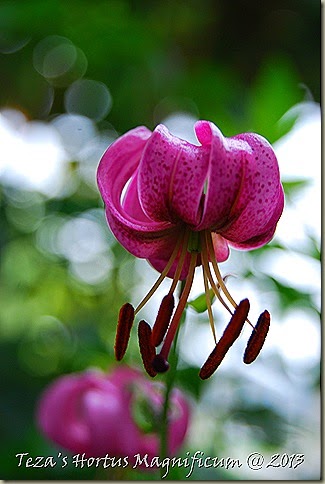
It was during an introductory visit to Lost Horizons, Ontario’s leading woodland garden nursery, that I first happened upon this wonderful genus! It was a stand of tall majestic near ebony stems, clothed in magnificent palmate foliage. Subtle but at the same time it drew my eye like a magnet! It was on another visit that I noticed that the tips of these branches were now laden with both buds and flowers of a most intoxicating cool yellow – with a texture that at best could be described as somewhat ‘waxy’ – the actual flowers themselves, of a tubular, shuttlecock shape. I think it was on this visit that I was given its identification, whereupon two pots came home with me. It has been an ongoing love affair ever since!

[Kirengeshoma palmata]
It is the floral branches that distinguish this genera’s second species, Kirengeshoma coreana [sometimes referred to as K.koreana Group] whose flowers are borne on stiffly upright inflorescence. It too, because if its rigid upright growth habit, can attain towering heights of 2.1m or more when happy! Hardy between Zones 4-10, it has been observed that while it does grow in warmer climates [zones 6-7] it tends to thrive in areas where summers are cooler. [ideally zone 5] Seed is generously produced and will germinate the following year if freshly sown, with seedlings blossoming in two or three years. Cuttings can also be taken in the early summer, once the stem tissue has hardened off, yet before flower production. Success is based on their firm establishment before the first winter. I have relied on division of the mature plants as my key to increasing this sublime woodland perennial within my shaded borders.
[Kirengeshoma coreana [koreana Group]
Both species remain quite happy along the Shaded Walk where they receive morning and late afternoon sun, planted in humus enriched soil that is never allowed to dry out. Constant moisture and well draining soil is essential to their survival.
[Kirengeshoma coreana [Koreana Group]
** W.George Schmid, in his ‘An Encyclopedia of Shade Perennials,’ says that the name of the genus comes from ki rengi shoma, the Japanese name for Anemonopsis, another divine Japanese woodland plant, which this genus is said to resemble! It is a member of the Hydrangeaceae family.




































4 comments:
One of my most (quietly) favourite plants in my garden too !
Your pictures are perfect Barry !
Joy : )
Kirengeshoma is such an under- appreciated genus for the woodland garden!If I'm allowed to dare recommend you an Aconitum as his companion!
(also I noticed I didn't hit the reply for my answer to your lily beetle Q - I was saying that in Europe is naturally kept under control by some parasitic wasps)
Joy:
I bring it in to the garden centre every year and it lasts a week on the benches tops!
Gabi:
Again, great botanically inclined minds, my three clumps have aconitum commingling in amongst them. The prettiest is A. uncinatum which I have clamoring up a circular obelisk. Bluish-purple and yellow in the garden at that time of year is drop dead gorgeous!
This is one of the most booootiful plants Barry. My colour is so pleasing colour and have made note to seek it out this spring. I love yellow in my shade garden and this will suit perfectly!
Post a Comment